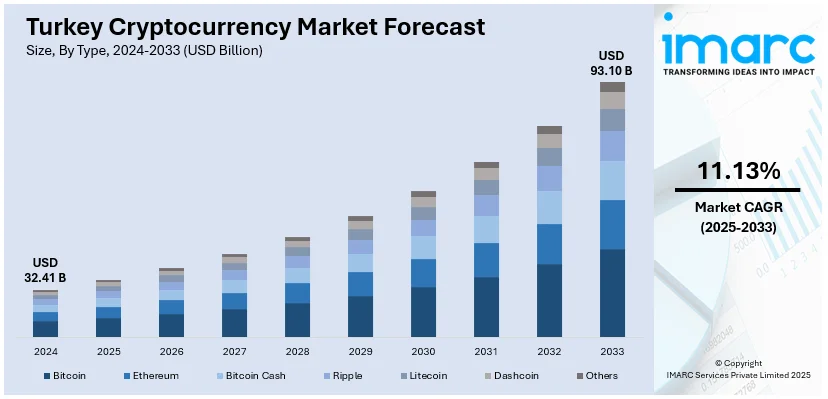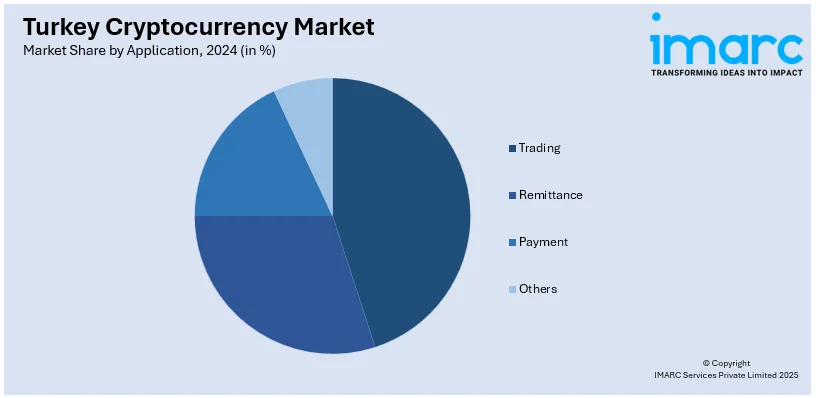
Turkey Cryptocurrency Market Size, Share, Trends and Forecast by Type, Component, Process, Application, and Region, 2025-2033
Turkey Cryptocurrency Market Overview:
The Turkey cryptocurrency market size reached USD 32.41 Billion in 2024. Looking forward, IMARC Group expects the market to reach USD 93.10 Billion by 2033, exhibiting a growth rate (CAGR) of 11.13% during 2025-2033. The digital currency industry is growing as digitalization is gaining pace in financial services and user behavior, facilitated by the young and digitally friendly population of the nation. Additionally, the government and financial regulators of the country are formulating regulation frameworks that are framing the cryptocurrency ecosystem. Furthermore, rising numbers of people using digital assets to make remittances and cross-border payments are expanding the Turkey cryptocurrency market share.
|
Report Attribute
|
Key Statistics
|
|---|---|
|
Base Year
|
2024
|
|
Forecast Years
|
2025-2033
|
|
Historical Years
|
2019-2024
|
| Market Size in 2024 | USD 32.41 Billion |
| Market Forecast in 2033 | USD 93.10 Billion |
| Market Growth Rate 2025-2033 | 11.13% |
Turkey Cryptocurrency Market Trends:
Increasing Digitalization and Youthful Demographics
Turkey's digital currency market is growing as digitalization is gaining pace in financial services as well as user behavior, facilitated by the young and digitally friendly population of the nation. As per the Society Volunteers Foundation, by 2025, Turkey's youth population in the 17-25 age range is projected to reach 12 million 719 thousand individuals. A large part of the population is young, and this age group is always using online channels, mobile apps, and digital payment platforms. Increasing usage of smartphones, social media, and fintech services is bringing cryptocurrencies into reach for common consumers. Also, digital natives are becoming increasingly inclined to look into alternative investment propositions, such as blockchain assets and decentralized finance (DeFi) protocols. Exchanges and wallet vendors are taking advantage of this trend by providing easy-to-use platforms and learning resources that are encouraging more engagement. As social media debate on influencer and awareness campaigns gains momentum, cryptocurrencies are becoming normalized in mainstream financial discourse. This shift in generations, coupled with growing digital infrastructure, is continually opening up conducive conditions for the development of the Turkish crypto market.

To get more information on this market, Request Sample
Widening Regulatory Framework and Institutional Interest
The government and financial regulators of Turkey are increasingly formulating regulation frameworks that are framing the cryptocurrency universe, while institutional investors are also increasingly interested. Policymakers are actively engaged in creating more transparent rules to oversee exchanges, transactions, and taxation, which is improving transparency and investor confidence. While regulations continue to shape themselves, the government is finally seeing the economic value of blockchain technologies and is incorporating cryptocurrency regulation into larger digital transformation agendas. Simultaneously, banks, payment processors, and fintech firms are starting to test crypto-related offerings, thus expanding access to the market. This growing institutional involvement is indicating maturity and is creating a safer context for individual investors. By countering fraud, money laundering, and consumer protection concerns, regulators are enhancing the integrity of the sector. Institutional trust and adoption are consistently growing as these frameworks are being perfected. Turkey has announced intentions for strict cryptocurrency regulations scheduled to be implemented in February 2025. These actions seek to synchronize Turkey’s anti-money laundering systems with international norms, influenced by the EU’s MiCA framework. Crypto service providers must authenticate the identities of users conducting transactions over 15,000 Turkish lira (£425) and unregistered wallets.
Growing Remittance and Cross-Border Transactions
The Turkish cryptocurrency market growth is propelled by the increasing number of people using digital assets to make remittances and cross-border payments, especially because of the huge expatriate population and migrant labor force that is linked with Turkey. Conventional remittance channels tend to be high in transaction costs, slow in processing, and pose a problem with currency exchange, thus not being efficient for the families that depend on foreign-based income. Cryptocurrencies and blockchain-based payment systems are increasingly providing faster, cheaper, and more transparent alternatives. Stablecoins are being used extensively in this area, as they are reducing the risk of volatility while facilitating near-instant transfer. Migrant workers and families are finding that digital assets are assisting them in avoiding traditional financial intermediaries, thus improving financial inclusion. With increasing global crypto adoption and better transaction platforms, the need for cross-border use of crypto is rising steadily in Turkey. It is not only fulfilling individual financial requirements but also strengthening wider cryptocurrency market adoption in the nation as a whole.
Turkey Cryptocurrency Market Segmentation:
IMARC Group provides an analysis of the key trends in each segment of the market, along with forecasts at the country and regional levels for 2025-2033. Our report has categorized the market based on type, component, process, and application.
Type Insights:
- Bitcoin
- Ethereum
- Bitcoin Cash
- Ripple
- Litecoin
- Dashcoin
- Others
The report has provided a detailed breakup and analysis of the market based on the type. This includes bitcoin, ethereum, bitcoin cash, ripple, litecoin, dashcoin, and others.
Component Insights:
- Hardware
- Software
A detailed breakup and analysis of the market based on the component have also been provided in the report. This includes hardware and software.
Process Insights:
- Mining
- Transaction
A detailed breakup and analysis of the market based on the process have also been provided in the report. This includes mining and transaction.
Application Insights:

- Trading
- Remittance
- Payment
- Others
A detailed breakup and analysis of the market based on the application have also been provided in the report. This includes trading, remittance, payment, and others.
Regional Insights:
- Marmara
- Central Anatolia
- Mediterranean
- Aegean
- Southeastern Anatolia
- Black Sea
- Eastern Anatolia
The report has also provided a comprehensive analysis of all the major regional markets, which include Marmara, Central Anatolia, Mediterranean, Aegean, Southeastern Anatolia, Black Sea, and Eastern Anatolia.
Competitive Landscape:
The market research report has also provided a comprehensive analysis of the competitive landscape. Competitive analysis such as market structure, key player positioning, top winning strategies, competitive dashboard, and company evaluation quadrant has been covered in the report. Also, detailed profiles of all major companies have been provided.
Turkey Cryptocurrency Market Report Coverage:
| Report Features | Details |
|---|---|
| Base Year of the Analysis | 2024 |
| Historical Period | 2019-2024 |
| Forecast Period | 2025-2033 |
| Units | Billion USD |
| Scope of the Report |
Exploration of Historical Trends and Market Outlook, Industry Catalysts and Challenges, Segment-Wise Historical and Future Market Assessment:
|
| Types Covered | Bitcoin, Ethereum, Bitcoin Cash, Ripple, Litecoin, Dashcoin, Others |
| Components Covered | Hardware, Software |
| Processes Covered | Mining, Transaction |
| Applications Covered | Trading, Remittance, Payment, Others |
| Regions Covered | Marmara, Central Anatolia, Mediterranean, Aegean, Southeastern Anatolia, Black Sea, Eastern Anatolia |
| Customization Scope | 10% Free Customization |
| Post-Sale Analyst Support | 10-12 Weeks |
| Delivery Format | PDF and Excel through Email (We can also provide the editable version of the report in PPT/Word format on special request) |
Key Questions Answered in This Report:
- How has the Turkey cryptocurrency market performed so far and how will it perform in the coming years?
- What is the breakup of the Turkey cryptocurrency market on the basis of type?
- What is the breakup of the Turkey cryptocurrency market on the basis of component?
- What is the breakup of the Turkey cryptocurrency market on the basis of process?
- What is the breakup of the Turkey cryptocurrency market on the basis of application?
- What is the breakup of the Turkey cryptocurrency market on the basis of region?
- What are the various stages in the value chain of the Turkey cryptocurrency market?
- What are the key driving factors and challenges in the Turkey cryptocurrency market?
- What is the structure of the Turkey cryptocurrency market and who are the key players?
- What is the degree of competition in the Turkey cryptocurrency market?
Key Benefits for Stakeholders:
- IMARC’s industry report offers a comprehensive quantitative analysis of various market segments, historical and current market trends, market forecasts, and dynamics of the Turkey cryptocurrency market from 2019-2033.
- The research report provides the latest information on the market drivers, challenges, and opportunities in the Turkey cryptocurrency market.
- Porter's five forces analysis assist stakeholders in assessing the impact of new entrants, competitive rivalry, supplier power, buyer power, and the threat of substitution. It helps stakeholders to analyze the level of competition within the Turkey cryptocurrency industry and its attractiveness.
- Competitive landscape allows stakeholders to understand their competitive environment and provides an insight into the current positions of key players in the market.
Need more help?
- Speak to our experienced analysts for insights on the current market scenarios.
- Include additional segments and countries to customize the report as per your requirement.
- Gain an unparalleled competitive advantage in your domain by understanding how to utilize the report and positively impacting your operations and revenue.
- For further assistance, please connect with our analysts.
 Request Customization
Request Customization
 Speak to an Analyst
Speak to an Analyst
 Request Brochure
Request Brochure
 Inquire Before Buying
Inquire Before Buying




.webp)




.webp)












